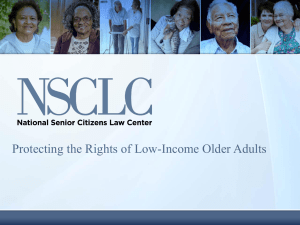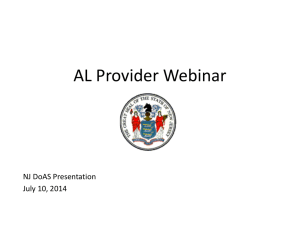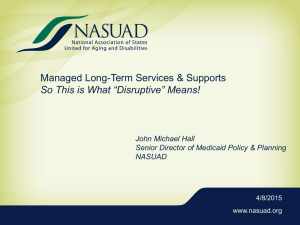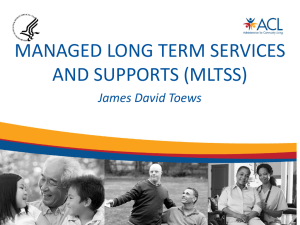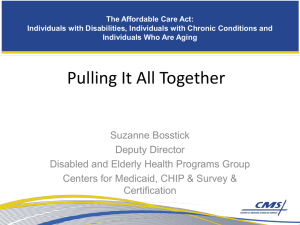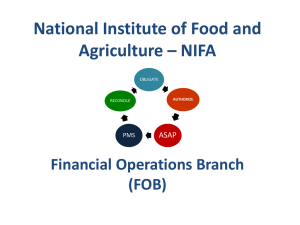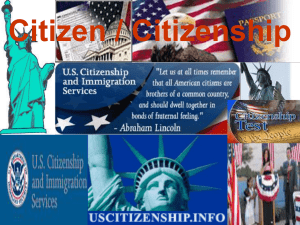This presentation
advertisement
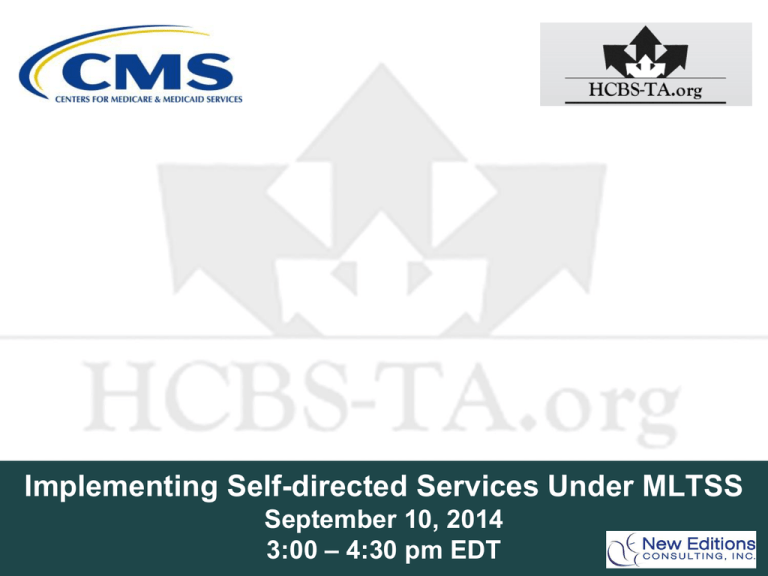
Implementing Self-directed Services Under MLTSS September 10, 2014 3:00 – 4:30 pm EDT Susan Flanagan Principal Westchester Consulting Group sflanagan@westchesterconsulting.com Suzanne Crisp Director of Program Design & Implementation NRCPDS suzanne.crisp@bc.edu Purpose of Webinar • Provide an overview of implementing self-directed services under a managed long-term services and supports (MLTSS) system. • Discuss the challenges and lessons learned, promising practices and strategies for successful implementation and monitoring. 3 Purpose of Webinar (cont’d) • Provide opportunities for participants to: —Talk to each other!! —Hear directly from a State agency representative about challenges and successful strategies in implementing self-directed services under MLTSS. —Learn about available resources. —Share and discuss ideas for adopting and/or adapting successful strategies for implementation and monitoring services and MCEs’ performance. 4 Learning Objectives • Participants will understand the: - Key components of self-directed services and the MLTSS delivery model, - States that have implemented and monitored the provision of self-directed services under MLTSS, and how one State accomplished this, and - Benefits, challenges, lessons learned and successful strategies for implementing self-directed services under MLTSS. 5 Who is on the call today? 6 What is Self Direction? • Self Direction (also known as consumer or participant direction) - Is a HCBS delivery model where individuals and their representatives, when applicable, have decisionmaking authority and take direct responsibility for managing their services with the assistance of selfdirected supports. - Represents a paradigm shift in HCBS delivery – transferring decision-making and managerial authority from providers to individuals and families while providing them with supports. 7 What are Self-directed Services? • Promote choice and control for individuals and families over their LTSS and the direct service workers who provide them. • In 2013, the NRCPDS survey of participant-directed service programs identified 269 programs operating in 50 states serving ~ 840,000 people 8 What are Self-directed Services?(cont’d) • They liberate a nontraditional direct service workforce of relatives and friends. - Many take advantage of the opportunity to hire relatives (i.e., 50 percent of participants in the RWJ Cash and Counseling Demonstration (Mahoney, 2005) and 72 percent of CA IHHS Program participants receiving Medicaid State Plan personal care services (CA DHHS, 2013)). 9 Options for Providing Self-directed Services Under Medicaid • §1915(i) HCBS SPA • §1915(k) Community First Choice SPA • §1915(j) Self-directed PAS SPA (overlies other authorities) • §1915(c) HCBS and §1115 Demonstration Waivers 10 Common Characteristics of Selfdirected Services • • • • Person-centered planning process Flexible service plan Individual budget Information & assistance (I&A) in support of self-direction • Financial management services (FMS) • Quality assurance and improvement 11 Key Domains of Self-directed Services • Degree of flexibility Employer Authority. Is the individual/ representative allowed to act as a common law or joint employer of his/her direct service workers and manage or actively participate in performing employer tasks? Budget Authority. Is the individual/representative allowed to develop and manage an individual budget of their LTSS and purchase individual-directed goods and services? 12 Key Domains of Self-directed Services (cont’d) • Supports available - Information and Assistance (I&A) - Financial Management Services (FMS) • Self-directed service implementation Developing FMS and I&A standards - Developing performance-based contracts and/or Medicaid provider certification requirements - 13 Key Domains of Self-directed Services (cont’d) - Ensuring self-directed service program is in compliance with 9/17/13 DoL FLSA Rule for Companionship and Live-in Exemptions to Domestic Service including determining state’s status as a third party joint-employer - Implementing FMS & I&A Readiness Review 14 Key Domains of Self-directed Services (cont’d) – Monitoring quality of: • Self-directed service delivery • FMS and I&A performance 15 Key Domains of Self-directed Services (cont’d) - Tools • Agreed upon procedures reviews • Reporting • Benchmarks • Assessing user experience and satisfaction (surveys) 16 Processing and Discussion • What is your biggest insight about what you just heard? 17 What is Managed LTSS? • Delivery system where States contract with managed care entities (MCE) defined at 42 CFR 438.2 to provide LTSS generally through a capitated monthly per member payment • MCE manages LTSS through degrees of financial risks for members • May be HCBS and/or institutional care 18 Why Do States Implement MLTSS Delivery Systems? • Looking for health care cost controls • Moving towards integrated, coordinated care – reduce fragmentation in service delivery • Focus on transition planning – Enrollees transitioning from institutions to HCBS 19 Options for Implementing MLTSS • Medicaid Authorities Vary – – – – – §1915(b)/(c) (FL, WI, MI, MN - SCP, NM*) §1115(a) (AZ, HI, NM*, TN & TX) §1915(a)/(c) (MA)(MN SHO) §1932(a) (WA) §1115(a)/1915(c) – (KS) *NM transitioned its §1915b/c to §1115(a) authority. *MN is transitioning its §1915(b)/(c) to §1115(a) authority. 20 CMS’ Position on Provision of Selfdirected Services Under MLTSS • CMS supports self-direction (SD) in both fee-forservice & managed care service delivery systems implemented under §1115(a) and §1915(b) (Most recently published in May 2013) States that offer self-directed services … are expected to continue…. States that do not currently offer self-directed services… should consider providing the opportunity…within a MLTSS program. 21 21 States Had MLTSS Programs as of May 2014, Up From 8 in 2004 (Truven Health Analytics) MLTSS implemented 1989-2004 MLTSS implemented 2005-May 2014 22 How Is Self Direction Beneficial to MCEs? • Positive response to advocates and member requests for more flexibility • Use of service coordination and efficiency strategies have the potential to provide more services for the same dollars 23 Selected Studies on Implementing Self-directed Services Under MLTSS • ASPE -Truven Five State Study (2013) – AZ, MA, NM, TN & TX • Mathematica/CMS Report: Selected Provisions from Integrated Care RFPs and Contracts: Participant Direction (2014) – ASPE Study States and FL, HI, KS, MI, MN, WA & WI 24 Study Methodology • Both studies use a qualitative case study method • ASPE-Truven Five State Study – Reviewed • Request for Proposals • Contracts • Policy & Procedures 25 Study Methodology (cont’d) – Interviewed • State Officials • Managed Care Entities (MCE) Administration & Service Coordinators • FMS Agencies • Advocacy Groups • Mathematica Study – Reviewed • Request for Proposals • Contracts • Policy & Procedures 26 Findings from Selected Studies • Findings Include: – Number of individuals who self-direct in MCEs – 77,500 – All States reviewed include people with disabilities and elders – Most “carve-out” intellectual and developmental disabilities – All but one State required the MCE to introduce the self direction option – All but one State include the essential elements of self direction in their contract with the MCE 27 Findings from Selected Studies (cont’d) – Wide variation in: • Number of members enrolled • Training for MCE service coordinators • Quality assurance/improvement, oversight, and monitoring – Some States rely on contracts to manage selfdirected services; others use policy & procedures – Four States offer employer and budget authority – Two States have recently dropped budget authority – In one State budget authority is limited to employment related issues 28 Findings from Selected Studies (cont’d) - Information & Assistance • Internal to MCE or subcontracted • One State created a new function to manage the day-to-day supports provided to members and coordinate activity with MCE case manager and FMS • Training is conducted by the MCE often with help from the Aging and Disability Network 29 Findings from Selected Studies (cont’d) - Most States require their final approval of FMS vendors used • • • States may delegate the selection and legal arrangement between the MCE and FMS States may arrange for FMS vendors directly States may execute the legal agreement or enter into a 3way contract between the State, the MCE and the FMS 30 Findings from Selected Studies (cont’d) - The number of FMS vendors used by a State varied - - from 1 to 400 Five States use Vendor F/EA FMS Six States use both Vendor F/EA FMS and Agency with Choice None of the States use the Government F/EA FMS Growing trend to offer both FMS models within a State 31 Observations • States play a major role in implementing self-direction and MLTSS. • Commitment to self direction is related to the State’s expectations and guidance. • Member introduction & orientation, and ongoing support of self direction can be timeconsuming for service coordinators and often is conducted in an inconsistent manner. 32 Observations (cont’d) • How self direction is presented is critical to a member’s understanding and willingness to use this service delivery option. • “Less is more” when implementing FMS so State can monitor performance of FMS vendors in an effective and timely manner. 33 Observations (cont’d) • It is unclear how committed MCEs are and their level of understanding of self direction. • Standardized training for MCE service coordinators is key for successful recruitment and retention of members using self direction. 34 Observations (cont’d) • Specific language/standards for self direction included in State policies and procedures may be more effective in implementing self direction under MLTSS than embedding self direction language in administrative contracts with MCEs 35 Processing and Discussion • What is your biggest insight about what you just heard? 36 State Successful Strategy Presenter • Michelle Morse Jernigan, Deputy, LTSS Quality Administration, TN Dept of Finance and Administration, Bureau of TennCare Michelle.m.jernigan@tn.gov (615) 507-6528 37 What Did We Do? • Tennessee implemented managed care in1994. – Mandate that all TennCare members enroll in managed care – Coordinated all physical and behavioral health needs – In 2010, the State implemented MLTSS - CHOICES 38 What Did We Do? (cont’d) • Implementation of CHOICES – “Carved in” LTSS • Nursing facility care and HCBS • Elders age 65+ and adults age 21+ with physical disability – Added Community Based Residential Alternatives to HCBS package – Added consumer direction option 39 What Did We Do? (cont’d) • Consumer Directed Option – Vendor Fiscal/Employer Agent (VF/EA) Financial Management Service (FMS) model used – 1,177 participants (as of 5/1/14) – 1,459 consumer-directed workers • Total CHOICES enrollment (as of 5/1/14) – NF = 18,170 (59%) – HCBS = 12,740 (41%) – ~ 9% of total HCBS members self-directing 40 Challenges & Lessons Learned • • Challenge: Enrolling elders and persons with physical disabilities took significantly longer than for individuals with intellectual/ developmental disabilities Lesson Learned: Enrollment differs by population and needs to be taken into consideration when developing policies and procedures. 41 Challenges & Lessons Learned (cont’d) • Challenge: Elders and persons with physical disabilities were confused about the role of the Supports Broker compared with the role of their Care Coordinator. • Lesson Learned: Need to lay out the roles and responsibilities clearly and compared to other care management roles. 42 Challenges & Lessons Learned (cont’d) • Challenge: Elders and persons with physical disabilities in CD didn’t feel they had to comply with State’s Electronic Visit Verification(EVV)System – wanted more flexibility in reporting workers’ time on job. • Lesson Learned: State needed to build more flexibility into the EVVS for reporting workers’ time on job. 43 Promising Practices • Prescriptive requirements • Contractor Risk Agreement (CRA) – MFP incentive • consumer direction enrollment benchmark – Care Coordinator • Introduces consumer direction at enrollment and annually 44 Promising Practices (cont’d) • VF/EA FMS contract – VF/EA FMS organization tasks • Enrollment and payroll management • Required to contract with the managed care entities (MCEs) – Supports Broker tasks • Train members • Assist with completion of all onboarding tasks (enrollment) 45 Promising Practices (cont’d) • Monitoring provision of services – Electronic visit verification – Care coordinator required contacts • Monitoring quality of care – Customer satisfaction surveys • TennCare and VF/EA FMS 46 Key Outcomes • Increased quality of life and care for members • 95% prefer choosing own workers • 97% like being in charge of directing their services • 91% think their life and health are better since using consumer-directed services • 99% of services provided when needed 47 Recommendations • Claims process between managed care organizations and VF/EA FMS entity – Implement tracking mechanism immediately • VF/EA FMS Request for Proposal Process 48 Recommendations (cont’d) • VF/EA FMS Readiness Review • Member/Representative Satisfaction Surveys – Use results 49 Processing and Discussion • What is your biggest insight about what you just heard? • What do you could do in your State/program that is similar? • What do think the challenges might be to implementing self-directed services under a MLTSS delivery system in your State/program? 50 Selected Resources • ASPE -Truven Five State Study: https://bcweb.bc.edu/libtools/details.php?entryid=417 • Financial Management Services and Managed LongTerm Services: • https://bcweb.bc.edu/libtools/details.php?entryid=377 • Mathematica/CMS Report: Selected Provisions from Integrated Care RFPs and Contracts: Participant Direction: http://www.chcs.org/usr_doc/RFP_Toolkit__Participant_Direction_4_28_14_(2).pdf 51 HCBS TA Available • Determining what authority will best meet your objectives. • Providing guidance on major features of §1915(i), including developing needs-based criteria. • Providing guidance on integrating §1915(i) with other services, such as §1915(c) waiver services. • Providing guidance on major features under a §1915(c) or §1115 waiver or §1915(i), (j) or (k) SPA, including implementing self-directed services and developing person-centered plans & budgets. 52 HCBS TA Available (cont’d) • Providing guidance on implementing self-directed services under MLTSS. • Providing clarification and assistance with the CMS waiver and state plan amendment application processes. • Identifying and addressing common barriers to implementation. 53 Examples of Topics for HCBS-TA • HCBS under §1915(i), (j) and (k) SPAs and §1915(c) and § 1115(a) waivers • Self-directed Services under §1915(i) (j) and (k) SPAs and §1915(c) and §1115(a) waivers • §1915(k) Community First Choice Option SPA • Person-centered Philosophy and Systems • Person-centered Planning • Individual Budgeting • Need Assessment • Positive Behavioral Supports 54 Examples of Topics for HCBS-TA (cont’d) • • • • • Supported Employment Community Integration Rate Setting Methodologies Managed Care including Managed LTSS Other Areas as Needed by States 55 Where to Find Help • To request TA: http://www.hcbs-ta.org/request.aspx • For additional information: http://www.hcbs-ta.org 56
